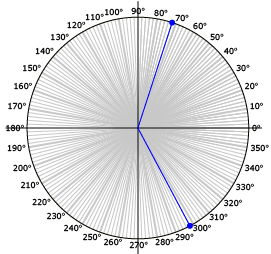Lesson 2
1. Lesson 2
1.1. Discover
Module 2: Trigonometry
Discover
In Lesson 1 you used the applet Primary Trigonometric Ratios: Formal Definitions to solve equations like cos θ = 0.7. You found that there were always two answers to this equation. In previous math courses you may have found one solution to this by writing θ = cos−1(0.7) then entering cos−1(0.7) into your calculator to get the answer 46°. How do you get the second solution (314°) without having to use the applet Primary Trigonometric Ratios: Formal Definitions?
In Try This 1 you will explore the relationship between the answer given by your calculator and the second answer given by the applet.
Try This 1
Print three copies of Circle of Angles. You will use one copy in each part of Try This 1. Do you prefer to work digitally? If so, you can paste a screenshot of Circle of Angles into a drawing program on your computer.
You will be using Primary Trigonometric Ratios: Formal Definitions, which you first used in Lesson 1.
Part 1
Step 1: Use Primary Trigonometric Ratios: Formal Definitions to determine the two values of θ that make the equation cos θ = 0.309 true.
Step 2: Draw these two angles in standard position on one of the Circle of Angles worksheets you printed. Mark a large point where each terminal arm intersects the circle. ![]()
Step 3: Fold the worksheet along the thick horizontal line (the x-axis). Record what you notice, if anything, about the two points on the terminal arms.
Step 4: Fold the worksheet along the thick vertical line (the y-axis). Record what you notice, if anything, about the two points on the terminal arms.
Repeat Steps 1 to 4 for the following equations.
- cos θ = 0.9135
- cos θ = −0.6691
- cos θ = −0.9976
Part 2
Step 1: Use Primary Trigonometric Ratios: Formal Definitions to determine the two values of θ that make the equation sin θ = 0.4695 true.
Step 2: Draw these two angles in standard position on the second Circle of Angles worksheet you printed. Mark a large point where each terminal arm intersects the circle.
Step 3: Fold the sheet along the thick horizontal line (the x-axis). Record what you notice, if anything, about the two points on the terminal arms.
Step 4: Fold the sheet along the thick vertical line (the y-axis). Record what you notice, if anything, about the two points on the terminal arms.
Repeat Steps 1 to 4 for the following equations:
- sin θ = 0.9613
- sin θ = −0.9272
- sin θ = −0.4384
Part 3
Step 1: Use Primary Trigonometric Ratios: Formal Definitions to determine the two values of θ that make the equation tan θ = 1.8807 true.
Step 2: Draw these two angles in standard position on the third Circle of Angles worksheet you printed. Mark a large point where the terminal arms intersect the circle.
Step 3: Fold the sheet along the thick horizontal line (the x-axis). Record what you notice, if anything, about the two points on the terminal arms.
Step 4: Fold the sheet along the thick vertical line (the y-axis). Record what you notice, if anything, about the two points on the terminal arms.
Repeat Steps 1 to 4 for the following equations:
- tan θ = 0.364
- tan θ = −0.2126
- tan θ = −2.4751
![]() Save your responses in your course folder.
Save your responses in your course folder.
Share 1
For each part of Try This 1, discuss the following questions with a partner or group.
- Does there appear to be a pattern to the relationship between each pair of angles you plotted?
- Can you see any relationship between the patterns you identified in Try This 1 and the primary trigonometric ratios introduced in Lesson 1?
![]() Save a summary of the patterns and relationships you discussed in your course folder.
Save a summary of the patterns and relationships you discussed in your course folder.
You will refer to your notes in Explore.
Your sheet will look similar to this:

